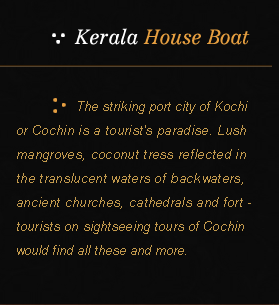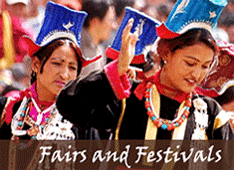Home > India Wildlife Tour > India's Own Mini Africa

Duration : 14 Days & 13 Nights
Location : Delhi – Bhopal – Bhimbetka – Satpura – Pench – Kanha – Bandhavgarh – Khajuraho – Delhi.
Location : Delhi – Bhopal – Bhimbetka – Satpura – Pench – Kanha – Bandhavgarh – Khajuraho – Delhi.
Day 01
Delhi Arrival:
COMPANY REPRESENTATIVE will receive you on arrival at the DELHI AIRPORT and transfer to your hotel.
DELHI, the capital of kingdoms and empires is now a sprawling metropolis with a fascinating blend of the past and the present. It is a perfect introduction to the composite culture of an ancient land. A window to the kaleidoscope - that is India.
Overnight will be at Delhi.
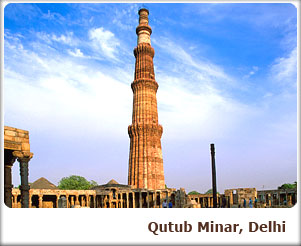 Day 02
Day 02
Delhi – Bhopal:
By Deluxe Train
Early morning you will be transferred to the railway station to board train for Bhopal. Reach and check into the hotel.
With an unmatched gore and glory, Bhopal, the capital town of Madhya Pradesh, is acclaimed as one of the most worth-visiting cities of the state. It served as the stronghold of Afghans and Mughals and later was the imperial seat of many 'Begums', who governed it from 1819 to 1926. The place has a landscape invested with the various trademark preferences of these rulers. Bhopal still conjures up images of a glorious past, in the form of its ancient temples, mosques & palaces. These prima donnas of Bhopal are vacationers' delight and constitute some of the prominent tourist attractions of Madhya Pradesh. Read this article and know about places of tourist interest to be seen in Bhopal.
Relax and then proceed for the sightseeing.
Laxmi Narayan Temple: Also known as Birla Temple, Laxmi Narayan temple was built by the Birlas and is commemorated to the Hindu deities, Laxmi & Vishnu. This sandy-yellow edifice, embellished with idols of many Hindu Gods and Goddesses, poses a magnificent sight. Birla Museum, adjoined to its precinct, is a storehouse of art and artifacts that date back to the 12th century. The beautifully carved archway and the trailing green lawns of the place make it a famous tourist draw of Bhopal.
Taj-ul Masjid: One of the largest and most beautiful mosques in India, Taj-ul-Masjid literally means 'The Crown of Mosques' and is an imposing landmark of Bhopal. Its pink façade, coroneted with white-domed minarets, soars to the skyline and stands as a stunning ovation to the rule of Begums in Bhopal. Its construction began under the regime of Shah Jehan Begum, but saw completion after her death. This striking monument is also used as a religious school (madarsa) during the day.
Shaukat Mahal: Shaukat Mahal exhibits Gothic and post-Renaissance architectural patterns and is a beautiful amalgamation of both oriental and occidental architectural styles. Thought to be designed by a Frenchman, it is strikingly different from the other Muslim monuments in its vicinity, especially with the triangular arches that adorn its roof. The white exterior of the building, carved with exquisite floral patterns, makes it stand out amongst all the antique monuments of Bhopal.
Sadar Manzil: Sadar Manzil is located near Shaukat Mahal and is an equally attractive site. Even today, the place highlights the bygone grandeur of the Nawabi era of Bhopal. It served as the hall of public audience of the erstwhile rulers of the place. Sultan Kaikhusrau Jahan Begum, daughter of Shah Jahan Begum, also used it as her private palace. Today, the building houses the headquarters of Bhopal Municipal Corporation.
Moti Masjid: Moti Masjid of Bhopal bears a prominent resemblance to the Jama Masjid of New Delhi. Built by Sikandar Jahan, the daughter of Kudsia Begum, in 1860, this staggering mosque brilliantly displays the heights attained by Islamic art and architecture during the Nawabi era. Fabricated with red sandstone, the highly stylized structure of the mosque is typical of Muslim architecture. It has an arresting marble façade, with two red minarets crowned by golden spikes.
Upper and Lower Lakes: These lakes highly contribute towards beautifying the landscape of Bhopal and are credited as the artwork of Raja Bhoj. The Upper Lake is 6 sq. km. in area and is divided from the Lower Lake by an over bridge. MP Tourism's Yacht Club provides facilities and warrants exciting trips by sail, paddle and motor boats at the Upper Lake. 'Van Vihar' (safari park) and the fish-shaped aquarium near the place also contribute towards its popularity amongst the locals and tourists.
Overnight will be at Bhopal.
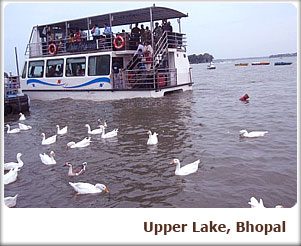 Day 03
Day 03
Bhopal – Excursion to Sanchi:
Breakfast will be at the hotel.
Proceed for an excursion to Sanchi.
Located in a serene backcloth, at a distance of 46 km from Bhopal, Sanchi is a little hamlet in Madhya Pradesh. The place is a treasure trove of ancient Buddhist architectural gems that deck its landscape in the form of monasteries, stupas, chaityas, temples and gateways. These antique relics, belonging from 3rd century BC to 12th century AD, are legacies of the heydays of Emperor Ashoka. The preponderance of Buddhism, in the form of its artwork, makes the place an important religious site of the Buddhists. This article will help you to unearth information on the various places to see in Sanchi and find out what its major tourist attractions are.
Stupas: These large hemispherical domes of Sanchi contain the relics of Buddha and demonstrate the artistic prowess of the Buddhist monks. Their structural magnificence and meticulousness are akin to the precision that are required by delicate jewelry. Owing to their splendid architectural trimmings, these stupas have been declared as a World Heritage Site by UNESCO.
Ashoka Pillar: The Great Stupa I or Atoka’s stupa is one of the major hallmarks of Sanchi. Ashoka Pillar lies close to the Southern Gateway of this Great Stupa. It was erected during 3rd century BC and majestically stands with its four lion head stump. Though the structure is quite similar to the famous carved pillar in Sarnath, it doesn't support a 'Wheel of Law' (Dharmachakra).
Gateways of Sanchi: The four 'Toranas' or Gateways (Eastern, Western, Northern and Southern) of Sanchi are a vivid description of Buddhist architectural geniuses. These ornamental gateways face the cardinal directions and capture the various phases of Buddha's life. They are carved with various symbolic representations, pertaining to the life, enlightenment, death and various incarnations of Buddha.
Buddhist Vihara: Buddhist Vihara enshrines the sacred relics of the Satdhara Stupa. They are placed inside a glass coffer, on a platform of the inner sanctum of this modern monastery. This Vihara is located a few kilometers from Sanchi and is a famous religious site of the Buddhists. It serves as a house of residence for the monks, who pursue religious studies here.
The Great Bowl: The Great Bowl of Sanchi is one of the major historical landmarks of the place. Excavations have credited the fact that this bowl was shaped from a single rock structure of enormous volume. During the early days, it was used to distribute food among Buddhist monks. The historical connotations invested on this monolithic boulder make it a popular attraction amongst the tourists.
Gupta Temple: The Gupta Dynasty, which ushered in a new era in the field of temple-architecture, has bestowed Sanchi with its trademark in the form of the famous Gupta Temple. This temple is located amidst the ruins of the Temple 17 of Sanchi and bears testimony to the aesthetic sense of proportion and balance shown by the artisans of the Gupta period.
Sanchi Museum: At Sanchi, there is a museum of the Archeological Survey of India that acts as a storehouse of many antique chattels and specimens. The museum has one main hall and four galleries. Valuable objects, excavated from different sites that are as old as 2000 yrs, are exhibited in this museum. The museum gives a glimpse of the lives and artwork of different dynasties. One of the notable specimens being displayed is the lion capital of the Ashoka Pillar in the main hall.
Overnight will be at Bhopal.
Day 04
Bhopal – Bhimbetka – Satpura:
By Road 210Kms/05hrs
Breakfast will be at the hotel.
Drive to Satpura visiting Bhimbetka enroute.
Bhimbetka caves of Madhya Pradesh, located 46 km south of Bhopal, is a valuable repository that acts like a sentinel to the prehistoric art and architecture of India. Infact, these caves claim a distinction as the largest treasure house of prehistoric art in the country. Dr V. S. Wakankar, one of the most renowned of Indian archeologists, discovered these caves. It was by a fluke of luck that he noticed these caves dotting distant hills, while on his way to Nagpur, in 1958. The word 'Bhimbetka', derived from 'Bhim Baitka', has mythological connotation. These caves are named after 'Bhima', one of the five Pandavas of Mahabharata.
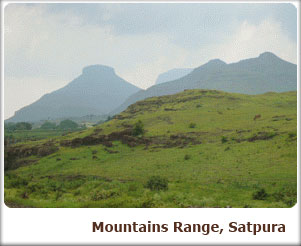 The discovery of Bhimbetka caves has indeed opened the floodgate of the immense popularity of the region of Bhimbetka. The entire region peppers with caves, more than 600 in number. Shaded in a thicket of teak and sal, amidst rock-strewn cliffs, they find enlistment as a World Heritage Site by UNESCO. Some of these caves also preserve paintings that traverse various eras. There are enchanting rock paintings that dates back to the Paleolithic, Mesolithic and Neolithic periods adorning these caves.
The discovery of Bhimbetka caves has indeed opened the floodgate of the immense popularity of the region of Bhimbetka. The entire region peppers with caves, more than 600 in number. Shaded in a thicket of teak and sal, amidst rock-strewn cliffs, they find enlistment as a World Heritage Site by UNESCO. Some of these caves also preserve paintings that traverse various eras. There are enchanting rock paintings that dates back to the Paleolithic, Mesolithic and Neolithic periods adorning these caves.
Continue drive to Satpura. Reach and check into the hotel.
Tucked away in the Satpura mountainous ranges, Satpura National Park rests in the Hoshangabad district of Madhya Pradesh. Set up in 1981, the park borrows its name from the Satpura hill ranges (Mahadeo Hills). An important wildlife sanctuary of India, the park shelters a rich biodiversity amidst its terrains. The panorama of the place, coupled with its herbaceous surroundings, makes it an ideal abode of many wildlife species of the country. The park has a jutted landscape, embedded with plain lands, and the altitude of the place ranges from 352 m to 1352 m.
Landscape and Flora: The landscape of Satpura Park is a veritable haven reflecting all the aspects of natural splendor. There are rocky sandstone peaks complemented by deep and dramatic ravines. The dense forests undulate with all its verdure and remains interspersed with some rare bryophytes and pteridophytes. Central Indian mixed deciduous vegetation is common in most of the areas. There are abundant sal, teak, tendu, aonla, mahua, bel and bamboo trees that throw in to the wealth of fauna in the park. Grasses and plants with therapeutic and medicinal properties are also widespread.
Fauna & Avifauna: When it comes to fauna, the Satpura National Park is a rare and exciting jungle treat. Its fauna comprises of animals like tiger, leopard, sambar, chital, bhedki, nilgai, four-horned antelope, rhesus monkey chinkara, bison, wild boar, wild dog, bear, black buck, fox, porcupine, flying squirrel, mouse deer and Indian joint squirrel, to name a few. There is also a huge collection of birds, about 254 species. Birds like Malabar pied hornbills, crested serpent eagles, crested hawk eagles, honey buzzards, paradise flycatchers, thrushes, peafowl and pheasants contribute to the varied avifauna of the park.
Overnight will be at Satpura.
Day 05
Satpura:
Breakfast will be at the hotel.
Proceed for full day game viewing inside the jungle. (Two safaris with lunch break in-between).
Overnight will be at Satpura.
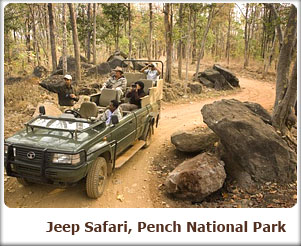 Day 06
Day 06
Satpura – Pench:
By Road 170Kms/05hrs
Breakfast will be at the hotel.
Drive to Pench. Reach and check into the hotel.
Pench National Park falls under the Seoni and Chhindwara districts of Madhya Pradesh. It derives its name from the Pench River that flows through its heart and divides it into two, equal western and eastern halves - Chhindwara and Seoni respectively. Declared as a wildlife sanctuary in 1977, eventually the place got elevated to the status of a National Park in 1983. Later, its eminence led to its incorporation under the umbrella of 'Project Tiger', as the 19th Project Tiger Reserve, in 1992. Sited on the southern fringes of Madhya Pradesh, the park covers a total area of 757.89 sq. km. Jabalpur and Nagpur serve as convenient airheads and railheads for reaching the park.
Landscape and Flora: The flora of Pench Tiger Reserve comprises mainly of Southern Indian tropical moist deciduous forest and tropical dry deciduous teak. Water bodies are found in the form of streams and 'nallahs'. Most of them are seasonal and meander in full zest during the monsoons. Pench River, which serves as the major water source, desiccates or dries up in April end. Then, water pools known as 'dohs' serve as water suppliers for the fauna of the park, along with Pench Reservoir. Teak is abundant and bamboos are sparse, and restricted to the valleys. White kuku trees are very common and stand out prominently amidst the greenery.
Fauna and Avifauna: Tigers are usually seen around the Pench River, as the density of prey population is higher here. There are 25 tigers recorded in this park. It is also the jungle abode of 39 species of mammals, 13 species of reptiles, 3 species of amphibians and over 170 varieties of birds. Major species of fauna include leopards, cheetal, sambar, nilgai, jackals, wild dogs, gaur, sloth bears, langoors, small Indian civets and palm civets. There are also more than 210 species of birds, including a host of migratory species. The most common birds are peafowl, crow pheasant, crimson breasted barbet, red vented bulbul, red jungle fowl, racket tailed drongo, magpie robin and whistling teal.
Overnight will be at Pench
Day 07
Pench:
Breakfast will be at the hotel.
Proceed for full day game viewing inside the jungle. (Two safaris with lunch break in-between).
Overnight will be at Pench.
Day 08
Pench – Kanha:
By Road 240Kms/06hrs
Breakfast will be at the hotel.
Drive to Kanha. Reach and check into the hotel.
A land that inspired Rudyard Kipling to write his classic novel 'Jungle Book', the forested areas of Kanha, with their wild thickets of sal and bamboo forests, rolling meadows and dramatic ravines, are home to the Kanha National Park. The Created in 1955, the national park is today the core area of the Kanha Tiger Reserve, which came into being in 1974, under Project Tiger. The Banjar and the Halon valley form the two halves constituting the vast stretches of land that is the Kanha Tiger Reserve.
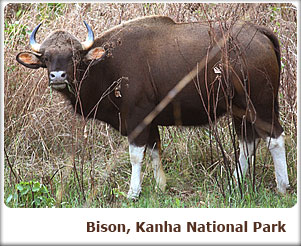 One of the greatest achievements of this park is perhaps its contribution in saving many endangered wildlife species, which nearly bordered extinction. The park today steadfastly guards the different genus of wildlife it domiciles and follows painstaking measures to maintain the overall protection of its flora, fauna and avifauna. The popular 'Sunset Point' or 'Bamni Dadar' inside the park is the best lookout point that allows visitors to soak the beautiful landscape of the park and relish rare sights of wildlife viewing.
One of the greatest achievements of this park is perhaps its contribution in saving many endangered wildlife species, which nearly bordered extinction. The park today steadfastly guards the different genus of wildlife it domiciles and follows painstaking measures to maintain the overall protection of its flora, fauna and avifauna. The popular 'Sunset Point' or 'Bamni Dadar' inside the park is the best lookout point that allows visitors to soak the beautiful landscape of the park and relish rare sights of wildlife viewing.
Wildlife: Trailing a wild tiger lazing around the shades of the forests of Kanha offers its own charm. In fact, the tigers remain the most exciting draw of the place. The park is also home to Sambars and Gaurs, which are generally seen in the green meadows, grazing away the grasses to glory. Animals like blackbuck and chital are also common sights. Other main wildlife attractions of the park include bison, barasingha, barking deer, black deer, chousingha, nilgai, mouse deer, sloth bear, jackal fox, porcupine, hyena, jungle cat, python, mongoose, and leopard.
Avifauna: Apart from the many species of animals that contribute to the wealth of fauna of this jungled beauty, one can also notice a wide variety of exotic birds here. Avifauna of the park include bird species like storks, peacocks, teals, pintails, pond herons, egrets, pea fowl, jungle fowl, spur fowl, papihas, partridges, ring doves, quails, spotted parakeets, green pigeons, rock pigeons, cuckoos, rollers, bee-eater, hoopoes, drongos, warblers, kingfishers, woodpeckers, finches, orioles, owls, and fly catchers. Thus, the place is indeed an ornithological wonder and a paradise for all bird watchers.
Overnight will be at Kanha.
Day 09
Kanha:
Breakfast will be at the hotel.
Proceed for full day game viewing inside the jungle. (Two safaris with lunch break in-between).
Overnight will be at Kanha.
Day 10
Kanha – Bandhavgarh:
By Road 240Kms/06hrs
Breakfast will be at the hotel.
Drive to Bandhavgarh. Reach and check into the hotel.
Bandhavgarh National Park is located in Umaria district on the extreme north- eastern border of Madhya Pradesh. Although Bandhavgarh is a small forest reserve, in the last few years, it has become one of the most prominent National Parks, owing to the high density of its tiger population. The mixed forests of Sal and bamboo and the abundance of water and prey create a very conducive atmosphere for the tiger population here. Bandhavgarh was declared a National Park in 1968 with an area of 105 sq. kilometers. The park is open from October to June every year and closed during the monsoons. There are three ways of exploring the forest here: vans, open jeeps or on elephants back. Apart from tigers you can also see sambar, chital, chinkara, barking deer, wild boar, leopard, and sloth bears.
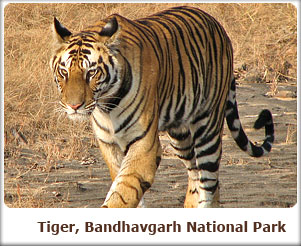 The Park is spread over an area of 437 sq. km. The terrain is made of rocky hills, sal forests and grazing areas, formerly agricultural land. The finest of these hills is the Bandhavgarh hill, and on its highest point stands Bandhavgarh Fort. Though no records remain to show when the fort was constructed, it is believed to be about 2000 years old. Several dynasties have ruled the fort: for example, the Maghas from the 1st century A.D, the Vakatakas from the 3rd century; the Sengars from the 5th century, and the Kalachuris from the 10th century. The oldest signs of habitation are the caves dug into the sandstone, near the fort. Several of these contain Brahmi inscriptions dating from the 1st century B.C. Prior to becoming a National Park, the forest range around the region had been maintained as a Shikargarh, or game preserve, of the Maharajahs of Rewa. It was only in 1968, that the area was declared as a National Park. Since then, stringent steps have been taken to retain it as an unspoilt natural habitat. The fort now is the private property of the Maharaja of Rewa and prior permission is required to visit it. A one hour trek leads up to the fort and the track is dotted by the small temples of the 12th century, unspoiled forests, and small meandering streams.
The Park is spread over an area of 437 sq. km. The terrain is made of rocky hills, sal forests and grazing areas, formerly agricultural land. The finest of these hills is the Bandhavgarh hill, and on its highest point stands Bandhavgarh Fort. Though no records remain to show when the fort was constructed, it is believed to be about 2000 years old. Several dynasties have ruled the fort: for example, the Maghas from the 1st century A.D, the Vakatakas from the 3rd century; the Sengars from the 5th century, and the Kalachuris from the 10th century. The oldest signs of habitation are the caves dug into the sandstone, near the fort. Several of these contain Brahmi inscriptions dating from the 1st century B.C. Prior to becoming a National Park, the forest range around the region had been maintained as a Shikargarh, or game preserve, of the Maharajahs of Rewa. It was only in 1968, that the area was declared as a National Park. Since then, stringent steps have been taken to retain it as an unspoilt natural habitat. The fort now is the private property of the Maharaja of Rewa and prior permission is required to visit it. A one hour trek leads up to the fort and the track is dotted by the small temples of the 12th century, unspoiled forests, and small meandering streams.
There are more than 22 species of mammals, and 250 species of birds. Some of the inhabitants of this park are the rhesus macaque, the black-faced langur, jungle cats, chinkara, black buck, munjtac and the chital. The Park attracts many migratory birds in the winter months that include the steppe eagle and a variety of wildfowl. Reptilian fauna include cobra, krait, python, turtle and a variety of lizards. The Bandhavgarh National Park has excellent game and bird viewing to offer, coupled with a fascinating historical element to it, thus satiating those adventurous at heart, completely.
The park can be explored on elephant back (also, a much preferred means of tiger-tracking) or in a vehicle. Jeep safaris are best undertaken, from dawn till about 10a.m, and from 4 p.m till dusk, as the animals are quite active during these periods.
Overnight will be at Bandhavgarh.
Day 11
Bandhavgarh:
Breakfast will be at the hotel.
Proceed for full day game viewing inside the jungle. (Two safaris with lunch break in-between).
Overnight will be at Bandhavgarh.
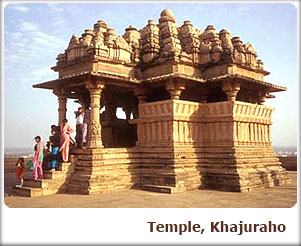 Day 12
Day 12
Bandhavgarh – Khajuraho:
By Road 260Kms/06hrs
Breakfast will be at the hotel.
Drive to Khajuraho. Reach and check into the hotel.
Khajuraho, which has lent its name to a complex of exquisite Hindu and Jain temples, is a small town located amidst the forested plains of Bundelkhand in north-central Madhya Pradesh. The beautiful temples that dot Khajuraho are believed to have been built by the mighty Chandela rulers in the 9th and 10th century AD. The engravings on these temples are highly sensual and erotic that depict in graceful forms intimate scenes of the whole range of human emotions and relationships. These sculptures congeal in stone a lyrical paean to love and passion and reflect the Chandela dynasty/’s immense appreciation for art.
Architecturally, the temples are built in the north Indian Nagara style. The sculptor/’s fine skill and a sense of imagination have given form to human emotion in the form of spiritual and physical love. Every façade—wall, window, pillar, and ceiling—is carved with figures of mythical and historical origins, and while many of these depict full-breasted, girdle-waisted women in forms of innocent play, they also depict carnal love.
Khajuraho combines history, architecture, culture and environment with delectable charm. It is a town that takes you away from the noise and pollution of the city, with its fresh air and scenic countryside. For convenience, the temples of Khajuraho are divided into the Western, Eastern, and Southern groups. The Western Group, situated opposite the Government of India Tourist Office, has 14 temples. The Chaunsath Yogini, Lalguan Mahadev, Parvati, Varaha, Matangesvara, Lakshmana, Vishvanath and Nandi, Chitragupta, Devi Jagdamba and Kandariya Mahadeo temples belong to this group. The Eastern Group, 2.4 km from the Tourist Office, consists of seven temples (four Jain and three Hindu). The Parsvanath, Adinath, Shantinath, and Ghantai temples belong to the Jains while the Vamana, Javari and Brahma are Hindu temples. The Southern Group, about 5 km from Khajuraho, contains the Chaturbhuj and Duladeo temples.
Overnight will be at Khajuraho.
Day 13
Khajuraho – Excursion to Panna:
After breakfast proceed for an excursion to Panna.
Sheltered in Madhya Pradesh, Panna National Park is at a distance of around 57 km from the nearby temple-town of Khajuraho. Panna city is especially famous for its diamond industry. Nevertheless, what adds to the popularity of the place is Panna Wildlife Sanctuary, which is also a renowned Tiger Reserve of India. The place sees major tourist footfalls due to its distinctive mark, as far as its wildlife variety is concerned. Moreover, tourists visiting Khajuraho also love to take a quick day out to this park. You can easily reach the Panna National Park by air or road from Khajuraho (57 km). By train, the most convenient railhead is Satna, located at a distance of 90 km from Panna.
Flora: As the climatic condition in this area mostly remains arid and hot, teak and dry mixed forest is what comprises the flora of Panna National Park. The total area of the place stretches to about 543 sq km and is a miscellany of dry deciduous forest, along with patches of prairies. Thorny woodlands and riverines also remain scattered amidst the blossoming vegetation. Trees like common teak, tendu, mahua and dhaora can be included among the wide varieties of floral species that form a major feature of the park.
Fauna: The animal wealth of Panna National Park is globally recognized. Animals like tigers, wild cats, deer and antelopes are some of the major species that the park boasts of. In fact, you can often spot tigers taking lazy strolls in the forested lands of the park. Leopards, wild dogs, wolves, hyenas, caracals are also frequent sights. The groves are speckled with animals like sambar and chowsingha. Sleepy dales cuddle many sloth bears and animals like nilgai and chinkara dot the open prairies. Reptiles are also another major attraction of this park.
Avifauna: You can witness a wide variety of avifauna, as the park houses more than 200 species of birds. It also shelters many migratory birds. White-necked stork, honey buzzard, king vulture, bareheaded goose, blossom headed parakeet, paradise flycatcher, slaty-headed scimitar, babbler are some of the many exciting and colorful birds that comprises the avifauna of the park.
Overnight will be at Khajuraho.
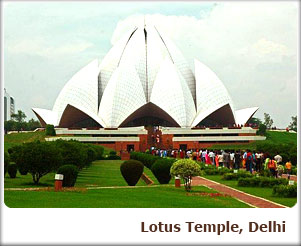 Day 14
Day 14
Khajuraho – Delhi – Departure:
By Air
Breakfast will be at the hotel.
Enjoy the sightseeing of FAMOUS WESTERN & EASTERN SET OF TEMPLES.
Transfer to the airport to take flight for Delhi. Reach and enjoy last minute shopping.
As per your INTERNATIONAL FLIGHT TIMINGS you’ll be transferred to the airport to take your flight back home with sweet memories of TIGER SAFARI TOUR.
...........................................................................TOUR ENDS...........................................................................
INCLUSIONS:
Delhi Arrival:
COMPANY REPRESENTATIVE will receive you on arrival at the DELHI AIRPORT and transfer to your hotel.
DELHI, the capital of kingdoms and empires is now a sprawling metropolis with a fascinating blend of the past and the present. It is a perfect introduction to the composite culture of an ancient land. A window to the kaleidoscope - that is India.
Overnight will be at Delhi.
 Day 02
Day 02 Delhi – Bhopal:
By Deluxe Train
Early morning you will be transferred to the railway station to board train for Bhopal. Reach and check into the hotel.
With an unmatched gore and glory, Bhopal, the capital town of Madhya Pradesh, is acclaimed as one of the most worth-visiting cities of the state. It served as the stronghold of Afghans and Mughals and later was the imperial seat of many 'Begums', who governed it from 1819 to 1926. The place has a landscape invested with the various trademark preferences of these rulers. Bhopal still conjures up images of a glorious past, in the form of its ancient temples, mosques & palaces. These prima donnas of Bhopal are vacationers' delight and constitute some of the prominent tourist attractions of Madhya Pradesh. Read this article and know about places of tourist interest to be seen in Bhopal.
Relax and then proceed for the sightseeing.
Laxmi Narayan Temple: Also known as Birla Temple, Laxmi Narayan temple was built by the Birlas and is commemorated to the Hindu deities, Laxmi & Vishnu. This sandy-yellow edifice, embellished with idols of many Hindu Gods and Goddesses, poses a magnificent sight. Birla Museum, adjoined to its precinct, is a storehouse of art and artifacts that date back to the 12th century. The beautifully carved archway and the trailing green lawns of the place make it a famous tourist draw of Bhopal.
Taj-ul Masjid: One of the largest and most beautiful mosques in India, Taj-ul-Masjid literally means 'The Crown of Mosques' and is an imposing landmark of Bhopal. Its pink façade, coroneted with white-domed minarets, soars to the skyline and stands as a stunning ovation to the rule of Begums in Bhopal. Its construction began under the regime of Shah Jehan Begum, but saw completion after her death. This striking monument is also used as a religious school (madarsa) during the day.
Shaukat Mahal: Shaukat Mahal exhibits Gothic and post-Renaissance architectural patterns and is a beautiful amalgamation of both oriental and occidental architectural styles. Thought to be designed by a Frenchman, it is strikingly different from the other Muslim monuments in its vicinity, especially with the triangular arches that adorn its roof. The white exterior of the building, carved with exquisite floral patterns, makes it stand out amongst all the antique monuments of Bhopal.
Sadar Manzil: Sadar Manzil is located near Shaukat Mahal and is an equally attractive site. Even today, the place highlights the bygone grandeur of the Nawabi era of Bhopal. It served as the hall of public audience of the erstwhile rulers of the place. Sultan Kaikhusrau Jahan Begum, daughter of Shah Jahan Begum, also used it as her private palace. Today, the building houses the headquarters of Bhopal Municipal Corporation.
Moti Masjid: Moti Masjid of Bhopal bears a prominent resemblance to the Jama Masjid of New Delhi. Built by Sikandar Jahan, the daughter of Kudsia Begum, in 1860, this staggering mosque brilliantly displays the heights attained by Islamic art and architecture during the Nawabi era. Fabricated with red sandstone, the highly stylized structure of the mosque is typical of Muslim architecture. It has an arresting marble façade, with two red minarets crowned by golden spikes.
Upper and Lower Lakes: These lakes highly contribute towards beautifying the landscape of Bhopal and are credited as the artwork of Raja Bhoj. The Upper Lake is 6 sq. km. in area and is divided from the Lower Lake by an over bridge. MP Tourism's Yacht Club provides facilities and warrants exciting trips by sail, paddle and motor boats at the Upper Lake. 'Van Vihar' (safari park) and the fish-shaped aquarium near the place also contribute towards its popularity amongst the locals and tourists.
Overnight will be at Bhopal.
 Day 03
Day 03 Bhopal – Excursion to Sanchi:
Breakfast will be at the hotel.
Proceed for an excursion to Sanchi.
Located in a serene backcloth, at a distance of 46 km from Bhopal, Sanchi is a little hamlet in Madhya Pradesh. The place is a treasure trove of ancient Buddhist architectural gems that deck its landscape in the form of monasteries, stupas, chaityas, temples and gateways. These antique relics, belonging from 3rd century BC to 12th century AD, are legacies of the heydays of Emperor Ashoka. The preponderance of Buddhism, in the form of its artwork, makes the place an important religious site of the Buddhists. This article will help you to unearth information on the various places to see in Sanchi and find out what its major tourist attractions are.
Stupas: These large hemispherical domes of Sanchi contain the relics of Buddha and demonstrate the artistic prowess of the Buddhist monks. Their structural magnificence and meticulousness are akin to the precision that are required by delicate jewelry. Owing to their splendid architectural trimmings, these stupas have been declared as a World Heritage Site by UNESCO.
Ashoka Pillar: The Great Stupa I or Atoka’s stupa is one of the major hallmarks of Sanchi. Ashoka Pillar lies close to the Southern Gateway of this Great Stupa. It was erected during 3rd century BC and majestically stands with its four lion head stump. Though the structure is quite similar to the famous carved pillar in Sarnath, it doesn't support a 'Wheel of Law' (Dharmachakra).
Gateways of Sanchi: The four 'Toranas' or Gateways (Eastern, Western, Northern and Southern) of Sanchi are a vivid description of Buddhist architectural geniuses. These ornamental gateways face the cardinal directions and capture the various phases of Buddha's life. They are carved with various symbolic representations, pertaining to the life, enlightenment, death and various incarnations of Buddha.
Buddhist Vihara: Buddhist Vihara enshrines the sacred relics of the Satdhara Stupa. They are placed inside a glass coffer, on a platform of the inner sanctum of this modern monastery. This Vihara is located a few kilometers from Sanchi and is a famous religious site of the Buddhists. It serves as a house of residence for the monks, who pursue religious studies here.
The Great Bowl: The Great Bowl of Sanchi is one of the major historical landmarks of the place. Excavations have credited the fact that this bowl was shaped from a single rock structure of enormous volume. During the early days, it was used to distribute food among Buddhist monks. The historical connotations invested on this monolithic boulder make it a popular attraction amongst the tourists.
Gupta Temple: The Gupta Dynasty, which ushered in a new era in the field of temple-architecture, has bestowed Sanchi with its trademark in the form of the famous Gupta Temple. This temple is located amidst the ruins of the Temple 17 of Sanchi and bears testimony to the aesthetic sense of proportion and balance shown by the artisans of the Gupta period.
Sanchi Museum: At Sanchi, there is a museum of the Archeological Survey of India that acts as a storehouse of many antique chattels and specimens. The museum has one main hall and four galleries. Valuable objects, excavated from different sites that are as old as 2000 yrs, are exhibited in this museum. The museum gives a glimpse of the lives and artwork of different dynasties. One of the notable specimens being displayed is the lion capital of the Ashoka Pillar in the main hall.
Overnight will be at Bhopal.
Day 04
Bhopal – Bhimbetka – Satpura:
By Road 210Kms/05hrs
Breakfast will be at the hotel.
Drive to Satpura visiting Bhimbetka enroute.
Bhimbetka caves of Madhya Pradesh, located 46 km south of Bhopal, is a valuable repository that acts like a sentinel to the prehistoric art and architecture of India. Infact, these caves claim a distinction as the largest treasure house of prehistoric art in the country. Dr V. S. Wakankar, one of the most renowned of Indian archeologists, discovered these caves. It was by a fluke of luck that he noticed these caves dotting distant hills, while on his way to Nagpur, in 1958. The word 'Bhimbetka', derived from 'Bhim Baitka', has mythological connotation. These caves are named after 'Bhima', one of the five Pandavas of Mahabharata.
 The discovery of Bhimbetka caves has indeed opened the floodgate of the immense popularity of the region of Bhimbetka. The entire region peppers with caves, more than 600 in number. Shaded in a thicket of teak and sal, amidst rock-strewn cliffs, they find enlistment as a World Heritage Site by UNESCO. Some of these caves also preserve paintings that traverse various eras. There are enchanting rock paintings that dates back to the Paleolithic, Mesolithic and Neolithic periods adorning these caves.
The discovery of Bhimbetka caves has indeed opened the floodgate of the immense popularity of the region of Bhimbetka. The entire region peppers with caves, more than 600 in number. Shaded in a thicket of teak and sal, amidst rock-strewn cliffs, they find enlistment as a World Heritage Site by UNESCO. Some of these caves also preserve paintings that traverse various eras. There are enchanting rock paintings that dates back to the Paleolithic, Mesolithic and Neolithic periods adorning these caves. Continue drive to Satpura. Reach and check into the hotel.
Tucked away in the Satpura mountainous ranges, Satpura National Park rests in the Hoshangabad district of Madhya Pradesh. Set up in 1981, the park borrows its name from the Satpura hill ranges (Mahadeo Hills). An important wildlife sanctuary of India, the park shelters a rich biodiversity amidst its terrains. The panorama of the place, coupled with its herbaceous surroundings, makes it an ideal abode of many wildlife species of the country. The park has a jutted landscape, embedded with plain lands, and the altitude of the place ranges from 352 m to 1352 m.
Landscape and Flora: The landscape of Satpura Park is a veritable haven reflecting all the aspects of natural splendor. There are rocky sandstone peaks complemented by deep and dramatic ravines. The dense forests undulate with all its verdure and remains interspersed with some rare bryophytes and pteridophytes. Central Indian mixed deciduous vegetation is common in most of the areas. There are abundant sal, teak, tendu, aonla, mahua, bel and bamboo trees that throw in to the wealth of fauna in the park. Grasses and plants with therapeutic and medicinal properties are also widespread.
Fauna & Avifauna: When it comes to fauna, the Satpura National Park is a rare and exciting jungle treat. Its fauna comprises of animals like tiger, leopard, sambar, chital, bhedki, nilgai, four-horned antelope, rhesus monkey chinkara, bison, wild boar, wild dog, bear, black buck, fox, porcupine, flying squirrel, mouse deer and Indian joint squirrel, to name a few. There is also a huge collection of birds, about 254 species. Birds like Malabar pied hornbills, crested serpent eagles, crested hawk eagles, honey buzzards, paradise flycatchers, thrushes, peafowl and pheasants contribute to the varied avifauna of the park.
Overnight will be at Satpura.
Day 05
Satpura:
Breakfast will be at the hotel.
Proceed for full day game viewing inside the jungle. (Two safaris with lunch break in-between).
Overnight will be at Satpura.
 Day 06
Day 06 Satpura – Pench:
By Road 170Kms/05hrs
Breakfast will be at the hotel.
Drive to Pench. Reach and check into the hotel.
Pench National Park falls under the Seoni and Chhindwara districts of Madhya Pradesh. It derives its name from the Pench River that flows through its heart and divides it into two, equal western and eastern halves - Chhindwara and Seoni respectively. Declared as a wildlife sanctuary in 1977, eventually the place got elevated to the status of a National Park in 1983. Later, its eminence led to its incorporation under the umbrella of 'Project Tiger', as the 19th Project Tiger Reserve, in 1992. Sited on the southern fringes of Madhya Pradesh, the park covers a total area of 757.89 sq. km. Jabalpur and Nagpur serve as convenient airheads and railheads for reaching the park.
Landscape and Flora: The flora of Pench Tiger Reserve comprises mainly of Southern Indian tropical moist deciduous forest and tropical dry deciduous teak. Water bodies are found in the form of streams and 'nallahs'. Most of them are seasonal and meander in full zest during the monsoons. Pench River, which serves as the major water source, desiccates or dries up in April end. Then, water pools known as 'dohs' serve as water suppliers for the fauna of the park, along with Pench Reservoir. Teak is abundant and bamboos are sparse, and restricted to the valleys. White kuku trees are very common and stand out prominently amidst the greenery.
Fauna and Avifauna: Tigers are usually seen around the Pench River, as the density of prey population is higher here. There are 25 tigers recorded in this park. It is also the jungle abode of 39 species of mammals, 13 species of reptiles, 3 species of amphibians and over 170 varieties of birds. Major species of fauna include leopards, cheetal, sambar, nilgai, jackals, wild dogs, gaur, sloth bears, langoors, small Indian civets and palm civets. There are also more than 210 species of birds, including a host of migratory species. The most common birds are peafowl, crow pheasant, crimson breasted barbet, red vented bulbul, red jungle fowl, racket tailed drongo, magpie robin and whistling teal.
Overnight will be at Pench
Day 07
Pench:
Breakfast will be at the hotel.
Proceed for full day game viewing inside the jungle. (Two safaris with lunch break in-between).
Overnight will be at Pench.
Day 08
Pench – Kanha:
By Road 240Kms/06hrs
Breakfast will be at the hotel.
Drive to Kanha. Reach and check into the hotel.
A land that inspired Rudyard Kipling to write his classic novel 'Jungle Book', the forested areas of Kanha, with their wild thickets of sal and bamboo forests, rolling meadows and dramatic ravines, are home to the Kanha National Park. The Created in 1955, the national park is today the core area of the Kanha Tiger Reserve, which came into being in 1974, under Project Tiger. The Banjar and the Halon valley form the two halves constituting the vast stretches of land that is the Kanha Tiger Reserve.
 One of the greatest achievements of this park is perhaps its contribution in saving many endangered wildlife species, which nearly bordered extinction. The park today steadfastly guards the different genus of wildlife it domiciles and follows painstaking measures to maintain the overall protection of its flora, fauna and avifauna. The popular 'Sunset Point' or 'Bamni Dadar' inside the park is the best lookout point that allows visitors to soak the beautiful landscape of the park and relish rare sights of wildlife viewing.
One of the greatest achievements of this park is perhaps its contribution in saving many endangered wildlife species, which nearly bordered extinction. The park today steadfastly guards the different genus of wildlife it domiciles and follows painstaking measures to maintain the overall protection of its flora, fauna and avifauna. The popular 'Sunset Point' or 'Bamni Dadar' inside the park is the best lookout point that allows visitors to soak the beautiful landscape of the park and relish rare sights of wildlife viewing.Wildlife: Trailing a wild tiger lazing around the shades of the forests of Kanha offers its own charm. In fact, the tigers remain the most exciting draw of the place. The park is also home to Sambars and Gaurs, which are generally seen in the green meadows, grazing away the grasses to glory. Animals like blackbuck and chital are also common sights. Other main wildlife attractions of the park include bison, barasingha, barking deer, black deer, chousingha, nilgai, mouse deer, sloth bear, jackal fox, porcupine, hyena, jungle cat, python, mongoose, and leopard.
Avifauna: Apart from the many species of animals that contribute to the wealth of fauna of this jungled beauty, one can also notice a wide variety of exotic birds here. Avifauna of the park include bird species like storks, peacocks, teals, pintails, pond herons, egrets, pea fowl, jungle fowl, spur fowl, papihas, partridges, ring doves, quails, spotted parakeets, green pigeons, rock pigeons, cuckoos, rollers, bee-eater, hoopoes, drongos, warblers, kingfishers, woodpeckers, finches, orioles, owls, and fly catchers. Thus, the place is indeed an ornithological wonder and a paradise for all bird watchers.
Overnight will be at Kanha.
Day 09
Kanha:
Breakfast will be at the hotel.
Proceed for full day game viewing inside the jungle. (Two safaris with lunch break in-between).
Overnight will be at Kanha.
Day 10
Kanha – Bandhavgarh:
By Road 240Kms/06hrs
Breakfast will be at the hotel.
Drive to Bandhavgarh. Reach and check into the hotel.
Bandhavgarh National Park is located in Umaria district on the extreme north- eastern border of Madhya Pradesh. Although Bandhavgarh is a small forest reserve, in the last few years, it has become one of the most prominent National Parks, owing to the high density of its tiger population. The mixed forests of Sal and bamboo and the abundance of water and prey create a very conducive atmosphere for the tiger population here. Bandhavgarh was declared a National Park in 1968 with an area of 105 sq. kilometers. The park is open from October to June every year and closed during the monsoons. There are three ways of exploring the forest here: vans, open jeeps or on elephants back. Apart from tigers you can also see sambar, chital, chinkara, barking deer, wild boar, leopard, and sloth bears.
 The Park is spread over an area of 437 sq. km. The terrain is made of rocky hills, sal forests and grazing areas, formerly agricultural land. The finest of these hills is the Bandhavgarh hill, and on its highest point stands Bandhavgarh Fort. Though no records remain to show when the fort was constructed, it is believed to be about 2000 years old. Several dynasties have ruled the fort: for example, the Maghas from the 1st century A.D, the Vakatakas from the 3rd century; the Sengars from the 5th century, and the Kalachuris from the 10th century. The oldest signs of habitation are the caves dug into the sandstone, near the fort. Several of these contain Brahmi inscriptions dating from the 1st century B.C. Prior to becoming a National Park, the forest range around the region had been maintained as a Shikargarh, or game preserve, of the Maharajahs of Rewa. It was only in 1968, that the area was declared as a National Park. Since then, stringent steps have been taken to retain it as an unspoilt natural habitat. The fort now is the private property of the Maharaja of Rewa and prior permission is required to visit it. A one hour trek leads up to the fort and the track is dotted by the small temples of the 12th century, unspoiled forests, and small meandering streams.
The Park is spread over an area of 437 sq. km. The terrain is made of rocky hills, sal forests and grazing areas, formerly agricultural land. The finest of these hills is the Bandhavgarh hill, and on its highest point stands Bandhavgarh Fort. Though no records remain to show when the fort was constructed, it is believed to be about 2000 years old. Several dynasties have ruled the fort: for example, the Maghas from the 1st century A.D, the Vakatakas from the 3rd century; the Sengars from the 5th century, and the Kalachuris from the 10th century. The oldest signs of habitation are the caves dug into the sandstone, near the fort. Several of these contain Brahmi inscriptions dating from the 1st century B.C. Prior to becoming a National Park, the forest range around the region had been maintained as a Shikargarh, or game preserve, of the Maharajahs of Rewa. It was only in 1968, that the area was declared as a National Park. Since then, stringent steps have been taken to retain it as an unspoilt natural habitat. The fort now is the private property of the Maharaja of Rewa and prior permission is required to visit it. A one hour trek leads up to the fort and the track is dotted by the small temples of the 12th century, unspoiled forests, and small meandering streams. There are more than 22 species of mammals, and 250 species of birds. Some of the inhabitants of this park are the rhesus macaque, the black-faced langur, jungle cats, chinkara, black buck, munjtac and the chital. The Park attracts many migratory birds in the winter months that include the steppe eagle and a variety of wildfowl. Reptilian fauna include cobra, krait, python, turtle and a variety of lizards. The Bandhavgarh National Park has excellent game and bird viewing to offer, coupled with a fascinating historical element to it, thus satiating those adventurous at heart, completely.
The park can be explored on elephant back (also, a much preferred means of tiger-tracking) or in a vehicle. Jeep safaris are best undertaken, from dawn till about 10a.m, and from 4 p.m till dusk, as the animals are quite active during these periods.
Overnight will be at Bandhavgarh.
Day 11
Bandhavgarh:
Breakfast will be at the hotel.
Proceed for full day game viewing inside the jungle. (Two safaris with lunch break in-between).
Overnight will be at Bandhavgarh.
 Day 12
Day 12 Bandhavgarh – Khajuraho:
By Road 260Kms/06hrs
Breakfast will be at the hotel.
Drive to Khajuraho. Reach and check into the hotel.
Khajuraho, which has lent its name to a complex of exquisite Hindu and Jain temples, is a small town located amidst the forested plains of Bundelkhand in north-central Madhya Pradesh. The beautiful temples that dot Khajuraho are believed to have been built by the mighty Chandela rulers in the 9th and 10th century AD. The engravings on these temples are highly sensual and erotic that depict in graceful forms intimate scenes of the whole range of human emotions and relationships. These sculptures congeal in stone a lyrical paean to love and passion and reflect the Chandela dynasty/’s immense appreciation for art.
Architecturally, the temples are built in the north Indian Nagara style. The sculptor/’s fine skill and a sense of imagination have given form to human emotion in the form of spiritual and physical love. Every façade—wall, window, pillar, and ceiling—is carved with figures of mythical and historical origins, and while many of these depict full-breasted, girdle-waisted women in forms of innocent play, they also depict carnal love.
Khajuraho combines history, architecture, culture and environment with delectable charm. It is a town that takes you away from the noise and pollution of the city, with its fresh air and scenic countryside. For convenience, the temples of Khajuraho are divided into the Western, Eastern, and Southern groups. The Western Group, situated opposite the Government of India Tourist Office, has 14 temples. The Chaunsath Yogini, Lalguan Mahadev, Parvati, Varaha, Matangesvara, Lakshmana, Vishvanath and Nandi, Chitragupta, Devi Jagdamba and Kandariya Mahadeo temples belong to this group. The Eastern Group, 2.4 km from the Tourist Office, consists of seven temples (four Jain and three Hindu). The Parsvanath, Adinath, Shantinath, and Ghantai temples belong to the Jains while the Vamana, Javari and Brahma are Hindu temples. The Southern Group, about 5 km from Khajuraho, contains the Chaturbhuj and Duladeo temples.
Overnight will be at Khajuraho.
Day 13
Khajuraho – Excursion to Panna:
After breakfast proceed for an excursion to Panna.
Sheltered in Madhya Pradesh, Panna National Park is at a distance of around 57 km from the nearby temple-town of Khajuraho. Panna city is especially famous for its diamond industry. Nevertheless, what adds to the popularity of the place is Panna Wildlife Sanctuary, which is also a renowned Tiger Reserve of India. The place sees major tourist footfalls due to its distinctive mark, as far as its wildlife variety is concerned. Moreover, tourists visiting Khajuraho also love to take a quick day out to this park. You can easily reach the Panna National Park by air or road from Khajuraho (57 km). By train, the most convenient railhead is Satna, located at a distance of 90 km from Panna.
Flora: As the climatic condition in this area mostly remains arid and hot, teak and dry mixed forest is what comprises the flora of Panna National Park. The total area of the place stretches to about 543 sq km and is a miscellany of dry deciduous forest, along with patches of prairies. Thorny woodlands and riverines also remain scattered amidst the blossoming vegetation. Trees like common teak, tendu, mahua and dhaora can be included among the wide varieties of floral species that form a major feature of the park.
Fauna: The animal wealth of Panna National Park is globally recognized. Animals like tigers, wild cats, deer and antelopes are some of the major species that the park boasts of. In fact, you can often spot tigers taking lazy strolls in the forested lands of the park. Leopards, wild dogs, wolves, hyenas, caracals are also frequent sights. The groves are speckled with animals like sambar and chowsingha. Sleepy dales cuddle many sloth bears and animals like nilgai and chinkara dot the open prairies. Reptiles are also another major attraction of this park.
Avifauna: You can witness a wide variety of avifauna, as the park houses more than 200 species of birds. It also shelters many migratory birds. White-necked stork, honey buzzard, king vulture, bareheaded goose, blossom headed parakeet, paradise flycatcher, slaty-headed scimitar, babbler are some of the many exciting and colorful birds that comprises the avifauna of the park.
Overnight will be at Khajuraho.
 Day 14
Day 14 Khajuraho – Delhi – Departure:
By Air
Breakfast will be at the hotel.
Enjoy the sightseeing of FAMOUS WESTERN & EASTERN SET OF TEMPLES.
Transfer to the airport to take flight for Delhi. Reach and enjoy last minute shopping.
As per your INTERNATIONAL FLIGHT TIMINGS you’ll be transferred to the airport to take your flight back home with sweet memories of TIGER SAFARI TOUR.
...........................................................................TOUR ENDS...........................................................................
INCLUSIONS:
- ACCOMODATION AT SUGGESTED HOTELS,
- DAILY BUFFET BREAKFASTS,
- AC VEHICLE WITH THE DRIVER FOR ALL TRANSFERS & SIGHTSEEING AS PER THE ITINERARY,
- MEET AND ASSIST AT THE AIRPORT/STATION ON ARRIVAL/DEPARTURE,
- ENGLISH SPEAKING LOCAL GUIDES AT APPLICABLE PLACES
- JEEP SAFARIS ON PER DAY BASIS IN SATPURA, PENCH, KANHA & BANDHAVGARH,
- NATIONAL PARK ENTRANCE FEES,
- ALL MEALS IN SATPURA, PENCH, KANHA & BANDHAVGARH,
- SOUND & LIGHT SHOW IN KHAJURAHO,
- EXCURSION TO SANCHI,
- EXCURSION TO BHIMBETKA,
- EXCURSION TO PANNA,
- TRAINFARE IN AC CHAIR CAR FROM DELHI – BHOPAL,
- AIRFARE IN ECONOMY CLASS FROM KHAJURAHO – DELHI,
- TOLL TAXES, DRIVER ALLOWANCE, PARKING, AND
- ALL APPLICABLE TAXES AND SERVICE CHARGES.
- LUNCHES & DINNERS,
- MONUMENT ENTRANCES,
- CAMERA CHARGES AT THE MONUMENTS,
- PORTER CHARGES,
- TIPS &
- PERSONAL EXPENSES.

